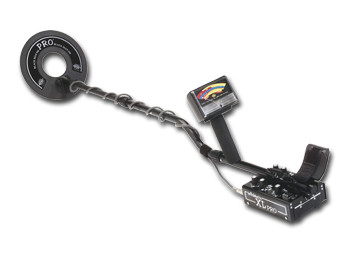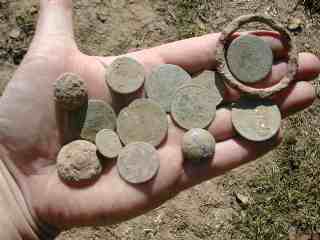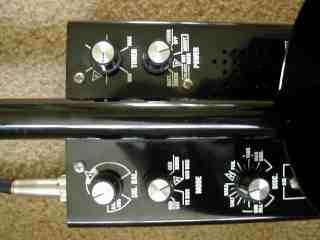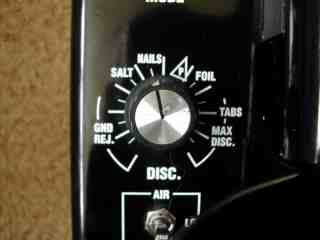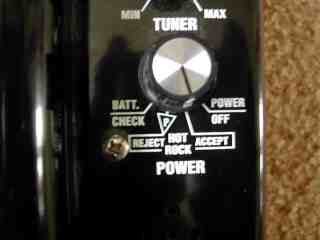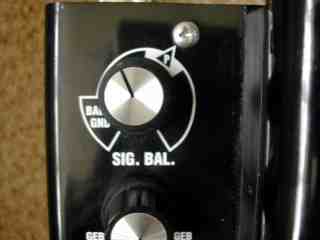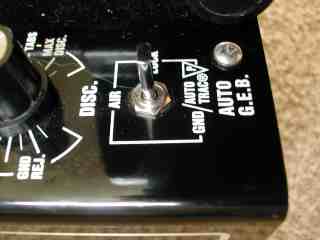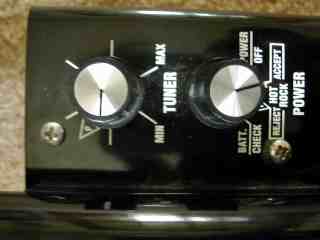|
Garys
Detecting.co.uk Whites 6000 Pro XL field test
I have been reading about the Whites 6000 pro XLfor some time,it has recently undergone an upgrade and made smaller thanks to modern technology.Several detectorists have been trading in there latest all singing metal detectors and buying XL Pro's, one thing I noticed is that nothing bad has ever been published about them,normally you get the odd one or two grumbles.That was enough to convince me to buy one and see for myself having sold my Whites DFX the cash was burning a hole in my pocket. When I got home after purchasing my new metal detector,I picked up the instruction manual and sat down for a quiet read,the first page was about assembling the machine, then I freaked, the next page went straight into GEB, SAT, GEB,TR Disc bla bla bla,to much information to quick Ted (Dougle father Ted), it went straight over my head, shell shocked I got up to put the kettle on, my XLT manual was so much easier to understand. Having recovered I looked at the control box, now things became a little clearer.In the manual Whites use the word "tuner" , which all it does in real life is adjust the audio threshold. The toggle switch is the auto or fixed ground balance, discrim yep we all know about that, hot rock reject/hot rock accept switch does just that, signal balance is basically the pre amp or sensitivity. The tricky one is the 4 way switch which says GEB SAT..TR DISC..GEB DISC..GEB NORM. For normal search conditions use GEB DISC marked with a P(preset) This mode allows audio discrimination aided by the meter readings, the others are for all metal and specialist searching. Read the manual at least 3 times then take it with you when you first go out searching.Someone else said it in plainer English on an earlier field test ..here is the extract. The Whites 6000 PRO XL has the following controls, switches and functions: Signal Balance: This control adjusts the amount of receive signal coming from the searchcoil. You can think of this as the sensitivity control on other brands. In low mineralization ground, the Signal Balance control can usually be set at or near its maximum setting. This will provide the best depth and sensitivity to targets. In higher mineralization, this control setting will need to be reduced to the point where the detector becomes smooth and stable. Tuner: The Tuner control sets the amount of background audio threshold level (hum). This should be set for the minimum audio sound possible. Mode: The Mode control (switch) is used to set the operating mode of the detector. Four choices are possible: GEB/NORM; GEB/DISC; TR/DISC; GEB/SAT. The GEB/NORM and GEB/SAT are all-metal modes, while the GEB/DISC and TR/DISC are discrimination modes. Most detectorists will use the GEB/DISC (motion) mode most of the time, but there are times and site conditions that may require the use of one of the other operating modes and may even be a better choice than the GEB/DISC mode. One very important feature of the Whites 6000 PRO XL is that its ID system and meter works in ALL modes of operation - even in its all-metal modes! This can be a real 'plus' for relic, coin and jewelry hunters who want to use the maximum depth, low-target masking properties of the all-metal modes and still reap the benefits of an accurate target ID system. I really like this feature. Power: The Power control turns the detector ON/OFF, selects either Hot Rock Accept or Hot Rock Reject, and tests the battery strength. The Hot Rock Accept mode provides maximum results, but in areas containing hot rocks, many false signals are likely while operating in this mode. The Hot Rock Reject setting cancels most responses caused by hot rocks and makes operation smoother, but may reject very deep or weak targets that appear similar to hot rocks in their response. It is recommended not to use this setting unless needed. The Hot Rock Reject setting has worked well for me while detecting some gravel-filled parking areas, old gravel roadways and even in some trashy sites where targets where not extremely deep. The Battery Check position of this control is used to check the condition of the batteries. A meter indication of '50' or above will operate the detector. If a reading of less than '50' is observed, batteries require replacement. Most batteries will provide from 8-16 hours of operating time. This 'time rating' will be dependent on battery type and brand, the use of headphones or not, and the operating mode selected. The 6000 PRO XL comes with White's standard drop-in battery pack (802-7150) that holds eight 'AA' type batteries. Discrimination: This control sets the amount of discrimination and should always be set to the lowest setting possible. The meter can and should be used to identify targets instead of just using the discrimination control to totally reject them. The discrimination control does not work with the GEB/MAX or GEB/NORM modes. Auto G.E.B.: The Auto GEB is used to select the actual ground rejection setting (ground balance). This feature is very easy to use and do. Once set, GND AUTO TRAC can be selected to automatically track any changes in the ground. This continual updating of the ground rejection setting improves performance. My first outing was with
Barry he uses a DFX and wanted to compare the machines in the field. I
turned my machine on put the loop at waist height, pushed the toggle switch
to "Air" it bleeped instantly, then lowered the coil to the ground and moved
the toggle to "GROUND" waited for a bleep, squeezed the trigger and that was
it the machine was ground balanced and ready to go, dead simple nothing like
the manual.The discrim was set to the Nails position the signal balance to
the pre set position, and the Tuner set so I got a slight hum in the
earphones. Field test part 2 Having now owned this machine for a month I have started to learn a lot more about its little quirks and bonuses Steve and myself visited the WW dig at Eaton Bray on Sunday hoping to carry out an extensive field test on the 6000,the ground was in stubble but very hard to dig, I have been trying to shake off a knee injury for quite some time, and trying to dig the hard ground had started things off again, within the first hour all we had dug up was lead, ringpulls and couple of Victorian halfpennys,hot rocks were beginning to be a real pain, although the needle on the 6000 told you it was a hot rock you still got an audio, which is fine but with one hot rock after another my patience was tested to the limits, depressed we decided to go to another site which has been well worked but in recent months has given up some Roman silver Denarius and the digging was very easy. Arriving at the field I set the machine so I could just hear a threshold, the discrim in the centre of the nails position and the signal balance below the pre set at 11 o'clock , I know from experience this field is highly mineralised ,the Whites XLT can only run pre amp 2, I then air and ground balanced and started searching, Steve was using his Whites XLT,this was an ideal time to compare both machines, the Whites 6000 ran very smoothly I found 2 large Georgian pennies the meter locked high up on the reading both times,having retrieved the target I picked the machine up to start searching to my surprise the meter was still locked on to the coin reading,which just goes to prove what an excellent piece of kit the analogue meter is, both coins came from a depth of 6 inches,I must point out on large targets the pin point gave quite a wide signal,the target can be easily shrunk simply by squeezing the trigger and releasing it whilst over the target,resulting in exact pin pointing every time. It was time to experiment so I turned the signal balance up to slightly above the pre set mark hoping to gain more depth, but this resulted in the machine becoming a little erratic and hot rocks being heard just like earlier in the day...So a lesson learned,,,dont try to pump the power up if the soil conditions will not allow it, depth will not be gained and the machine will be swamped by false signals. Over the next 2 hours I recovered several coins at good depths, no silver Roman this time, Steve had about the same amount of targets(and junk) so the machines were quite evenly matched. After a cuppa and some food we decided to bury a small hammered at 4 inches, both machines found it with no problem, then 6 inches. no problem, both machines gave a broken signal at 7 inches with a brisk swing speed, confirming the depth capabilities of the two machines were the same, the coin could be found with the Whites 6000 at 6 inches even with the power turned down to just above the "Bad Ground" decal just proving that this machine works just as well with the power below the suggested pre sets. The Whites 6000 pro xl is a great all rounder ideal for the detectorist who wants XLT performance without the hassle of technical programming.
My 6000Pro xl setiings for relic hunting in bad ground
The 6000 controls Set Discrimination here
Dig anything on the meter Hot rock accept or reject
Dont turn the power to high Switch the auto trac to fixed(center)
Adjust tuner so a faint threshold can be heard Good signals will be loud and clear with a positive meter reading, even small hammereds will be clear, hot rocks will peg the meter to the far right and will disappear in pin point,Some iron can cause the meter to flicker but will not lock on. Likes Very stable operation Meter is very honest Great Depth Whites excellent after sales service Dislikes Not supplied with re-charge kit No box cover available Marks 8.5/10 Please send your metal detector field tests to garysdetecting@hotmail.com
|
